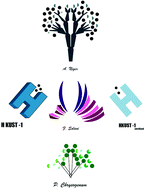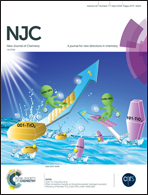The fungicide effect of HKUST-1 on Aspergillus niger, Fusarium solani and Penicillium chrysogenum†
Abstract
In this work we have evaluated the fungicide effects causing the growth inhibition of Aspergillus niger, Fusarium solani and Penicillium chrysogenum using three metal–organic framework materials (MOFs): HKUST-1 (three-dimensional structure), HKUST-1NP doped with copper oxide nanoparticles (CuO-NPs) and sterilized HKUST-1 (which generated a one-dimensional Cu(BTC)(OH)(H2O)-type structure). The materials were synthesized by stirring at room temperature under atmospheric pressure, and were compared to commercial CuO-NPs to evaluate the toxic effects using a radial growth (inhibition halo) technique. The MOFs were thoroughly dispersed in culture media, and the fungi were cultured on potato dextrose agar plates containing different concentrations of the tested materials. A thorough characterization of the studied materials was carried out through PXRD, FTIR, N2 adsorption, TGA and SEM measurements in order to determine the physicochemical properties. For A. niger, none of the tested materials inhibited its growth; it hence proved to be resistant, due to its ability to leach copper from the compounds. In the case of F. solani, concentrations between 750 to 1000 ppm caused 100% inhibition of growth. For P. chrysogenum, it was observed that increasing the concentration of MOFs up to 1000 ppm caused a concomitant increase in inhibition. This work represents the first report underlining the possible use of MOFs as fungicides, and the results have shown growth inhibition capability in some species, opening up possible new applications in this field.



 Please wait while we load your content...
Please wait while we load your content...